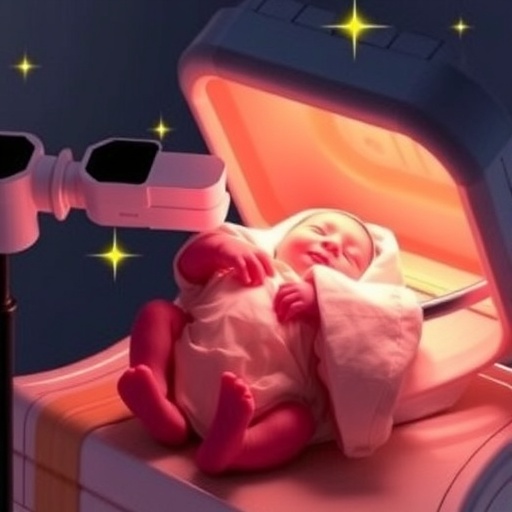In the realm of neonatal medicine, hyperbilirubinemia remains a significant clinical challenge, affecting a substantial subset of newborns worldwide. This condition, characterized by an excessive accumulation of bilirubin in the blood, often necessitates immediate intervention to prevent irreversible neurological damage such as kernicterus. A recent groundbreaking study by Li and Hu published in Pediatric Research (2025) introduces an innovative approach known as bilicocoon phototherapy, marking a promising advancement in the therapeutic landscape for neonatal hyperbilirubinemia.
Neonatal hyperbilirubinemia arises primarily due to the immature hepatic systems in neonates which fail to adequately conjugate and excrete bilirubin, a breakdown product of hemoglobin. Traditionally, phototherapy has served as the gold standard treatment, utilizing blue-spectrum light to convert bilirubin into water-soluble isomers that can be excreted without hepatic conjugation. However, the effectiveness of conventional phototherapy devices is limited by factors such as exposure area, intensity, and the photoconversion efficiency of bilirubin.
Bilicocoon phototherapy, an innovative concept developed and scrutinized by researchers Li and Hu, redefines the phototherapeutic interface by enveloping the neonate within a cocoon-like apparatus equipped with advanced LED arrays. This design significantly enhances phototherapeutic coverage, ensuring uniform irradiation over the infant’s body surface. Importantly, the technology harnesses a meticulously calibrated wavelength spectrum optimized to maximize bilirubin photoconversion while minimizing adverse thermal effects.
The mechanics underpinning bilicocoon phototherapy rely on maximizing skin penetration by visible light in the blue to green spectrum, typically between 460 to 490 nanometers. These wavelengths are adept at facilitating structural isomerization of bilirubin molecules, converting them into lumirubin and other photoisomers that are more readily excreted. Beyond wavelength optimization, the bilicocoon system utilizes a reflective inner lining, amplifying photon scattering and enhancing the irradiance dose delivered to the neonate’s skin.
Critically, Li and Hu’s study details a comprehensive evaluation of bilicocoon phototherapy’s clinical efficacy. Their randomized controlled trial encompassed a diverse cohort of neonates with varying severities of hyperbilirubinemia. Data indicate a statistically significant reduction in total serum bilirubin levels within 24 hours of initiating bilicocoon therapy compared to conventional light sources. Moreover, the time to reach clinically safe bilirubin thresholds was notably shortened, suggesting accelerated bilirubin clearance kinetics.
Safety parameters were rigorously assessed, with the innovative design addressing common pitfalls of traditional phototherapy such as heat accumulation and dehydration. The bilicocoon’s integrated cooling system and real-time thermal regulation markedly reduced incidents of hyperthermia. Furthermore, protective shielding minimized retinal light exposure risks, an essential consideration given infants’ photosensitivity and vulnerability to photic injury.
Beyond immediate clinical outcomes, the researchers also explored bilicocoon’s influence on physiological stress markers. By measuring cortisol levels and other stress-related biomarkers, the team inferred that the enclosed, gentle illumination environment reduces neonatal distress during therapy. This represents a significant improvement in neonatal care standards, potentially enhancing long-term neurodevelopmental trajectories by mitigating stress-related impacts.
The practical implications of bilicocoon phototherapy extend into healthcare logistics and economics. Its design facilitates ease of use and mobility, allowing for bedside application without cumbersome equipment. This is particularly advantageous in resource-limited settings where conventional phototherapy units may be scarce or unreliable. Cost analyses suggested that, despite initial higher device expenses, reduced hospital stays and improved patient outcomes could render bilicocoon technology economically favorable in the long term.
Additionally, Li and Hu’s work delves into the photochemical pathways induced by bilicocoon therapy, employing spectroscopic and molecular analyses to elucidate the transformation of bilirubin. Their findings contribute to a deeper mechanistic understanding of bilirubin photodegradation, revealing nuanced interactions between photon energy, skin chromophores, and bilirubin molecules. Such insights pave the way for refining and tailoring phototherapeutic regimens across varying clinical scenarios.
Moreover, the bilicocoon’s design incorporates smart technology features including real-time bilirubin monitoring via non-invasive transcutaneous sensors. This integration supports dynamic adjustment of light intensity and exposure duration, ensuring personalized therapy optimized for each neonate’s metabolic capacity and bilirubin excretion profile. The seamless blend of therapeutic and diagnostic functionalities embodies the future trajectory of neonatal care innovation.
The study’s multidisciplinary approach, drawing expertise from neonatology, photophysics, bioengineering, and clinical pharmacology, underscores the complexity and promise of bilicocoon phototherapy. It signifies a paradigm shift not only in treatment efficacy but also in the holistic management of neonatal hyperbilirubinemia, encompassing safety, comfort, and healthcare system integration.
While additional large-scale trials and longer follow-up periods are requisite to fully validate bilicocoon’s long-term impact and scalability, this initial evidence positions it as a formidable contender in neonatal phototherapeutic interventions. Researchers anticipate that bilicocoon technology could become the new benchmark, supplanting existing phototherapy standards and reducing the global burden of bilirubin-induced neurologic dysfunction.
As bilicocoon phototherapy advances toward clinical adoption, its innovative principles may also inspire the development of novel applications addressing other dermatological and systemic neonatal disorders responsive to photomedicine. The study by Li and Hu invites a broader reconsideration of phototherapy’s role in contemporary neonatal intensive care and beyond.
Ultimately, the promise of bilicocoon phototherapy lies not only in its capacity to improve immediate neonatal outcomes but in its potential to alter the life trajectories of millions of infants worldwide. By effectively mitigating the risks associated with hyperbilirubinemia, this novel intervention exemplifies the intersection of technology and compassionate care poised to transform neonatal medicine profoundly.
Subject of Research: Neonatal hyperbilirubinemia and phototherapy treatment innovation
Article Title: Evaluating bilicocoon phototherapy for neonatal hyperbilirubinemia
Article References:
Li, X., Hu, F. Evaluating bilicocoon phototherapy for neonatal hyperbilirubinemia. Pediatr Res (2025). https://doi.org/10.1038/s41390-025-04457-4
Image Credits: AI Generated




